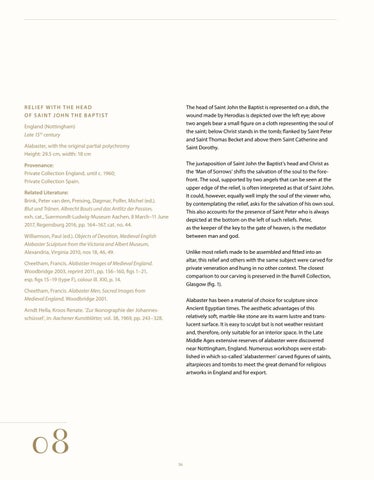RELIEF WITH THE HEAD OF SAINT JOHN THE BAPTIST
The head of Saint John the Baptist is represented on a dish, the wound made by Herodias is depicted over the left eye; above two angels bear a small figure on a cloth representing the soul of the saint; below Christ stands in the tomb; flanked by Saint Peter and Saint Thomas Becket and above them Saint Catherine and Saint Dorothy.
England (Nottingham) Late 15 th century Alabaster, with the original partial polychromy Height: 29.5 cm, width: 18 cm
The juxtaposition of Saint John the Baptist’s head and Christ as the ‘Man of Sorrows’ shifts the salvation of the soul to the forefront. The soul, supported by two angels that can be seen at the upper edge of the relief, is often interpreted as that of Saint John. It could, however, equally well imply the soul of the viewer who, by contemplating the relief, asks for the salvation of his own soul. This also accounts for the presence of Saint Peter who is always depicted at the bottom on the left of such reliefs. Peter, as the keeper of the key to the gate of heaven, is the mediator between man and god.
Provenance: Private Collection England, until c. 1960; Private Collection Spain. Related Literature: Brink, Peter van den, Preising, Dagmar, Polfer, Michel (ed.). Blut und Tränen. Albrecht Bouts und das Antlitz der Passion, exh. cat., Suermondt-Ludwig-Museum Aachen, 8 March–11 June 2017, Regensburg 2016, pp. 164 –167, cat. no. 44. Williamson, Paul (ed.). Objects of Devotion, Medieval English Alabaster Sculpture from the Victoria and Albert Museum, Alexandria, Virginia 2010, nos 18, 46, 49.
Unlike most reliefs made to be assembled and fitted into an altar, this relief and others with the same subject were carved for private veneration and hung in no other context. The closest comparison to our carving is preserved in the Burrell Collection, Glasgow (fig. 1).
Cheetham, Francis. Alabaster Images of Medieval England. Woodbridge 2003, reprint 2011, pp. 156 –160, figs 1– 21, esp. figs 15 –19 (type F), colour ill. XXI, p. 14. Cheetham, Francis. Alabaster Men, Sacred Images from Medieval England, Woodbridge 2001.
Alabaster has been a material of choice for sculpture since Ancient Egyptian times. The aesthetic advantages of this relatively soft, marble-like stone are its warm lustre and translucent surface. It is easy to sculpt but is not weather resistant and, therefore, only suitable for an interior space. In the Late Middle Ages extensive reserves of alabaster were discovered near Nottingham, England. Numerous workshops were established in which so-called ‘alabastermen’ carved figures of saints, altarpieces and tombs to meet the great demand for religious artworks in England and for export.
Arndt Hella, Kroos Renate. ‘Zur Ikonographie der Johannesschüssel’, in: Aachener Kunstblätter, vol. 38, 1969, pp. 243 – 328.
08
56














